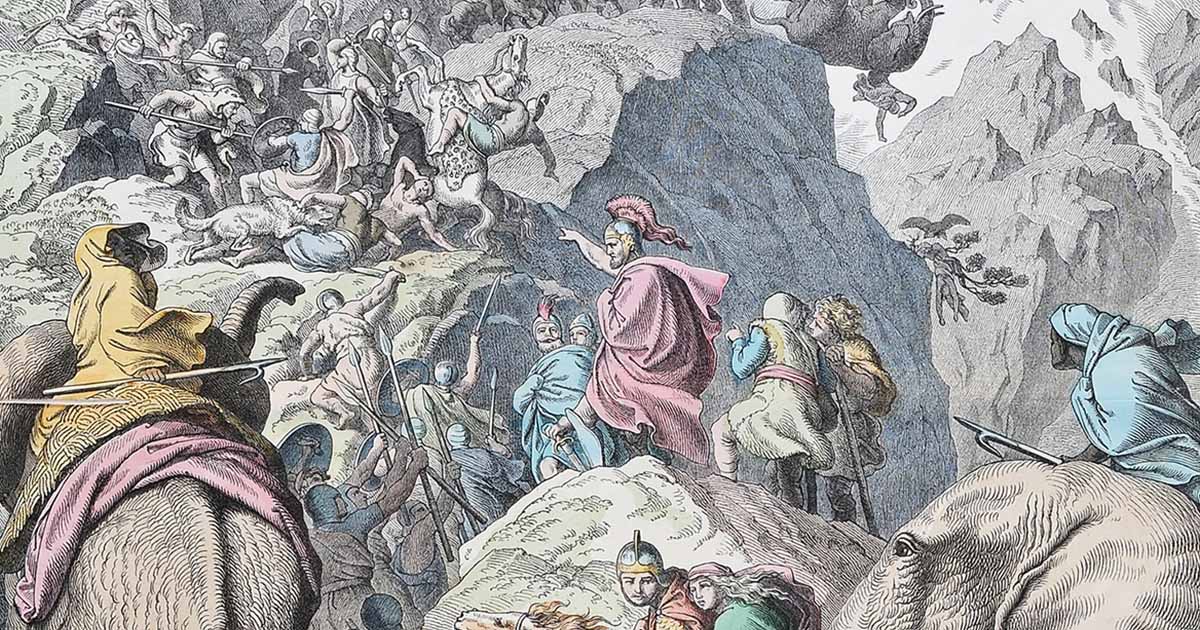Unsolved Mystery: The Mysterious Origins of Hannibal's Elephants
The saga of the perilous journey of the Carthaginian general Hannibal across the Alps during the Second Punic War was immortalized not only by his military prowess but also by the awe-inspiring presence of Hannibal's elephants. Yet, a lingering question echoes through time: Where did these war elephants originate? Were Hannibal’s elephants from Asia or Africa? Join us on this exploration of a historical riddle that has captivated minds for centuries.
The Backstory: Hannibal's Elephants and the Audacious Alpine Odyssey
Hannibal Barca, a name that echoes through the corridors of ancient military history, emerged as a formidable Carthaginian general during the Second Punic War, spanning from 218 to 201 BC. Renowned for his strategic brilliance and audacious military tactics, Hannibal's legacy is perhaps most indelibly marked by his daring utilization of war elephants during a campaign that would become an enduring tale of triumph over adversity.
Around 218 BC, Hannibal embarked on a perilous mission to join forces with anti-Roman allies. Leading a colossal army of 100,000 troops, a force that would be eternally etched in history, he included a striking contingent of 40 war elephants in his ranks. Remembered as Hannibal’s elephants, this decision to incorporate war elephants into his military strategy was both bold and revolutionary, revealing Hannibal's capacity for innovative and unconventional warfare.
Hannibal's elephants, colossal creatures armed for battle, were not just a logistical choice but a strategic masterpiece. While the use of elephants in warfare wasn't unprecedented, Hannibal's decision to navigate the challenging terrain of the Alps with these massive beasts was unprecedented and audacious. The journey through the Alps proved to be a formidable challenge, with the harsh conditions claiming lives among both soldiers and Hannibal’s elephants.
- The Second Punic War – Hannibal’s Infamous Offensive
- Hannibal of Carthage: Military Commander and Greatest Enemy of Rome
Yet, despite the difficulties, Hannibal's successful traversal of the Alps stands as a testament to his military genius. The image of war elephants navigating the treacherous mountain passes left an indelible mark on contemporaries and future generations alike. Hannibal's elephants became emblematic of his audacity, determination and his willingness to employ unconventional methods to achieve strategic goals.
The significance of Hannibal's elephants lay not only in their awe-inspiring spectacle but also in their tactical prowess. In the heat of battle, these colossal creatures served as living battering rams, striking fear into the hearts of opposing forces. Their sheer size disrupted enemy formations, providing Hannibal with a unique and powerful advantage.
Hannibal's campaign, marked by the daring use of war elephants, etched his name into the annals of military history. The journey through the Alps, though perilous, solidified Hannibal's reputation as a military genius.
His war elephants, traversing the challenging terrain, became an enduring symbol of audacity and strategic ingenuity. Hannibal's legacy endures, with the memory of Hannibal’s elephants navigating the Alps forever enshrined in the collective memory as one of the most captivating and audacious moments in the history of warfare.

Hannibal's Army Crossing the Rhone, Henri Paul Motte, 1878, featuring Hannibal’s elephants. (Public domain)
Where Did Hannibal’s Elephants Actually Come From?
While the crossing of the Alps was an incredible journey that helped to seal Hannibal’s place as one of the greatest military leaders in history, there are many mysterious aspects of the journey that have been analyzed, but never solved. One of the greatest of those mysteries is where Hannibal got his pack of elephants.
War elephants have a long history of military use, yet the precise origin of Hannibal's substantial elephant force remains unclear. In Hannibal's era, only two elephant species existed – the Asian and African varieties. Hannibal, residing in Carthage, present-day Tunisia along the Mediterranean, faced a geographical challenge. The distance between Carthage and Asia, as well as the region south of the Sahara where African elephants primarily dwelled, raises intriguing questions about how he acquired such a vast array of these colossal creatures.
It has not been determined whether Hannibal used Asian elephants, African elephants, or a combination of the two. Looking at the characteristics of each type of elephant may provide insight into which species would have been preferable for Hannibal’s needs.
Arguments For and Against Hannibal Having Used African Elephants
While it is believed that Hannibal might have preferred the more manageable Asian elephants due to their smaller size and easier trainability, historical evidence paints a more complex picture. Arguments favoring the use of African elephants point to the challenges of controlling these majestic creatures, coupled with their larger size, making them potentially less suitable for military endeavors.
The difficulty in training and directing elephants was a crucial consideration for any military commander. Traditionally it has been claimed that African elephants, known for their independent nature, could pose significant challenges on the battlefield. Nevertheless, this point of view has come under attack with several experts claiming that African elephants are not inherently less trainable than Asian elephants.
According to Professor Graeme Cumming, writing in The Guardian, “it is a widespread fallacy that African elephants are untrainable. The largest working group in Africa, to my knowledge at least, was in the then Belgian Congo earlier this century.” In the eyes of professionals, training success in elephants depends on individual temperament, handler expertise and training methods, rather than on species.
While both species are trainable, Asians are often considered more manageable due to their smaller size. The bigger size of African elephants has also been cited as a reason for them being less suitable for military purposes, and certainly less desirable for a treacherous trek across the Alps. However, training outcomes vary widely among individual elephants, regardless of species. “Indeed, their larger size and greater aggressiveness would have made these beasts more fearsome than Asian elephants,” continued Cumming.

Hannibal crossing the Alps on elephants, by Nicolas Poussin. (Public domain)
Could Hannibal’s Elephants Have been an African Forest Subspecies?
Historical conjecture surrounds the origin of the elephants in Hannibal's army, with some historians proposing a fascinating possibility. It is suggested that Hannibal's elephants hailed from a small forest subspecies residing in the Atlas Mountains of Morocco and Algeria. These elephants, standing at a modest eight feet tall at the shoulders, differed significantly from their larger African counterparts. However, their diminutive size might have rendered them less practical for military purposes, challenging the conventional image of mighty war elephants on the battlefield.
In an article published in The New York Times, Gavin de Beer, a prominent figure at the British Museum of Natural History in the 1950s, contributed insights into these elephants. Describing them as both smelly and loud, de Beer highlighted the potential challenges associated with their temperament. Moreover, their dangerous nature during a charge, as noted by de Beer, could have presented additional difficulties in deploying them effectively in a military context.
Coincidentally, a coin dating from Hannibal's era features an image of an elephant, potentially offering visual evidence that supports the presence of African elephants in his army. The depiction on the coin may align with the characteristics of the smaller forest subspecies, adding a layer of historical nuance to the ongoing discourse about Hannibal's strategic choices and the specific type of elephants he may have led through the challenges of the Alps.

Silver double shekel coin of Carthage, depicting Hannibal and an elephant. (The Trustees of the British Museum / CC BY-NC-SA 4.0)
Was Surus, the Lone Survivor of Hannibal’s Elephants, an Asian Elephant?
Certain historians have claimed that stories of Surus, whose name translates to mean “the Syrian” and who is believed to have been the lone survivor of Hannibal’s miliary campaign, provides evidence that Hannibal’s elephants were Asian in origin.
- Military Historian Discovers Hannibal’s Long-Lost Battlefield
- War Elephants: The Military ‘Tanks’ of the Ancient World
The name "Surus" suggests a connection to Syria, indicating a potential lineage tracing back to elephants seized by the Ptolemies of Egypt during their campaigns in Syria. These elephants were likely brought back to Carthage, serving as a valuable addition to Hannibal's diverse array of war elephants. The fact that Hannibal himself supposedly rode Surus highlights the significance of this particular elephant in his military strategy.
While Surus provides compelling evidence supporting the presence of Asian elephants in Hannibal's army, it doesn't necessarily mean that all of Hannibal’s elephants were Asian. In fact, the mention that Surus may have been a descendant of elephants acquired during Egyptian campaigns hints at the possibility that Hannibal sourced his elephants from various regions, creating a diverse ensemble to bolster his military might.
The Riddle of the Provenance of Hannibal’s Elephants
In truth, it may never be known for sure exactly where Hannibal’s elephants came from. Being large creatures that need a great amount of sustenance, it is likely that any journey transporting elephants would have been complicated. This meant that Hannibal’s elephants would have required much advanced planning. It is therefore likely that Hannibal was less concerned with exactly where his elephants came from. He would probably have been more focused on whether they would be an asset to his military forces during the Second Punic War.
The discovery in September 2023 of a bone in southern Spain did little to provide answers. On the one hand, the bone was believed to have potentially belonged to an elephant used by either Hannibal or the army of Julius Caesar. On the other, an article in El País reported that Rafael Martínez, a zoologist from University of Córdoba, concluded after examining the bone that it was a “carpal belonging to the right hand, a bone also known as capitatum, of an African or Indian elephant. It is very difficult to determine the species, whether Asian ( Elephas maximus) or African ( Loxodonta Africana).”
Top image: Detail depicting of the famous crossing of the Alps by Hannibal’s elephants. Hannibal's Crossing of the Alps by Heinrich Leutemann. Source: Public domain
By M R Reese
References
Mosig, Y. 18 May 2013. “Hannibal’s Elephants: Myth and Reality” in The History Herald. Available at: https://thehistoryherald.com/Articles/Ancient-History-Civilisation/Hannibal-and-the-Punic-Wars/hannibal-s-elephants-myth-and-reality/
Noble Wilford, J. 18 September 1984. “The Mystery of Hannibals’ Elephants” in The New York Times. Available at: https://www.nytimes.com/1984/09/18/science/the-mystery-of-hannibal-s-elephants.html


















Comments
Well, elephants are easy to domesticate. If you started a farm with a few of them, you could produce a big herd over time; but it would take some years or decades; while they are long-lived like humans, they reproduce much slower.
That said, I find the Hannibal story NOT believable. Militarily-speaking, it would be too dumb, too slow and risky, to take elephants over the Alps. IF THEY MADE IT across without injury or collapse, how good would they be in battle? ...And not as if fantasy and legend DOES NOT find their way into the history books.
Nobody gets paid to tell the truth.
HANNIBAL WAS NO DOUBT A BLACK AFRICAN GENERAL FROM THE NORTH AFRICAN COUNTRY OF CARTHAGE, TODAY'S TUNISIA. ETRURIA COINS OF THE GENERAL DEPICTS HIM AND HIS ELEPHANT, AS A DEDICATION FOR HIS ABILITY TO WIN BATTLES AGAINST ROME, WHILE ROME WAS AN ENEMY TO THE ETRUSCAN PEOPLE, AND SOON DESTROYED THEM AFTER CARTHAGE HAD BEEN DESTROYED..
Charles Bowles
I think hannibal is Ethiopian General
They would have been Indian through trade. African animals cannot be tamed. Jared Diamond has proved this. African animals evolved alongside humans and regard us as evil monkeys. Asian animals had no idea what we were till we walked up and slaughtered them.
He probably collected them from all over.
Peace and Love,
Ricky.
Pages